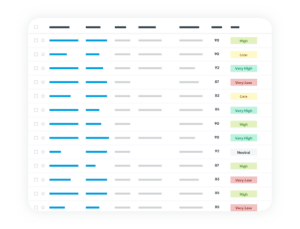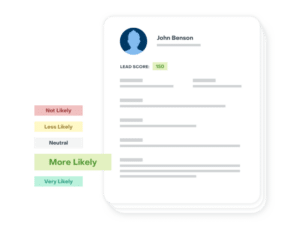Personalizing Customer Engagement Doesn’t Have To Be Complicated
Reimagining Customer Experience in a Post-Covid World
Today brands must aspire to meet customer needs in a personalized manner to establish a genuine connection with customers. Creating a personalized customer experience requires customer-facing teams to work from the same data set to preserve consistency while delivering a human touch.
But many organizations face challenges when building a single source of truth—one being traditional CRM solutions poorly equipped to connect every stakeholder with a complete view for creating a high-definition customer experience. In our 2022 CRM Impact Report, three-quarters of businesses say a unified view of sales, marketing, and service is critical to delivering an optimal customer experience. However, the lack of such a data infrastructure fuels a customer relationship crisis.
Organizations can be more customer-centric and leverage the modern merits of CRM solutions powered by artificial intelligence (AI) to help optimize and personalize engagement throughout the customer journey.

Overcoming the Challenge of Customer Flight
The findings from our study pinpoint organizational turbulence across the customer journey while highlighting the inadequacies of traditional CRM solutions that aren’t purpose-built to address today’s post-pandemic customer experience realities. Customer experiences that don’t match expectations put companies at risk for churn. Today, customers worldwide are leaving in droves—at a rate of nearly 1 in 2 in the US and 1 in 3 worldwide. It appears a Great Customer Resignation is upon us, but companies shouldn’t resign themselves that this can’t be reversed and resolved. The key is identifying the gaps between what customers expect and what they experience.
This includes gathering customer engagement data points, identifying customer sentiment indicators, and tracking customer service performance in real-time. In addition, deploying AI-driven predictive intelligence such as personalized recommendations, next-best actions, relevant cross-sell opportunities and leveraging AI to identify customers at risk early based on predictive models.
Becoming Data-Driven to Personalize the Experience
The more you know about your customers, the easier it is to create consistent and personalized sales, marketing, and service activity. Yet fifty-six percent of those surveyed feel they are missing data to improve their marketing campaigns and sales conversions. Worse, 1 in 4 sales professionals believes they could miss a quota because of incomplete data across the customer lifecycle.
Data fuels the actionable insights that sales, marketing, and service teams need to act decisively at every critical touchpoint throughout the customer journey. Sales teams, for example, that can see what’s happening on the service front can better identify upsell and cross-sell opportunities and create more personalized communications with customers.
This can be achieved with a shared CRM data platform that connects every stakeholder, ensuring no blind spots, no busy work, and no roadblocks.
Demystifying Lead Qualification to Increase Your Odds of Success
Generating qualified leads remains an elusive task for many organizations. Fifty-four percent of respondents say that the sales leads generated by marketing are either poorly qualified or underqualified, and nearly one-third (27%) of sales leads are never followed up on.
A unified CRM allows sales, marketing, and service teams to clearly define what good leads look like, helping to personalize outreach and add intelligence to lead qualification, deal tracking, opportunity management, and customer engagement.

Marketing has the greatest insight into how each customer engages the brand, such as what content is being downloaded, what type of events they’re attending, and where they’re falling off in the marketing funnel. Sales have keener insights into product and business-related needs that influence every deal. By better scoring account opportunities, tracking conversion rates, and sharing customer preference insights, sales and marketing can synchronize their strategy for generating and acting on the most valuable leads.
Improving Sales, Marketing, and Service Team Alignment
It’s not easy to orchestrate coordinated sales, marketing, and service activities. And it only gets more complicated when each group works from different datasets, playbooks, KPIs, and definitions of success. Our research revealed that almost two-thirds of sales and marketing leaders agree that sales and marketing misalignment prevents their organization from growing their business adequately. Some of the top reasons for this include: Incompatible KPIs or incentivized by different goals (72%), systems not integrated or different technology platforms (61%), and poor communication between teams (45%).
Organizations must establish a common terminology or definition of each metric and jointly determine which KPIs have the most significant impact on the customer experience. In addition, companies must focus on valuable metrics such as retention rates and document an internal handoff process to ensure a seamless transition from marketing to sales, service, finance, and other vital customer-facing groups.
Driving Exceptional Customer Experiences with AI
Investments in AI are on the rise due to its ability to make sense of overwhelming data volumes, trends, or hidden insights and to increase productivity and optimize efficiency. Not surprisingly, sales and marketing use cases have seen some of the highest adoption rates, as they can directly impact revenue.

AI has moved beyond visionary to mainstream technology adoption. With more data available—especially from digital channels, AI can enable better customer experiences, personalized engagement, accurate predictions, and better decision making. The wide range of AI usage and its critical impact on business transformation is likely why 91% say they expect to use AI technology to augment existing processes to increase over the next 24 months. The use cases for AI solutions with high adoption include automated emails (44%), account intelligence (40%), conversational AI (36%), lead conversion (33%), and opportunity close prediction (33%).
Resolving the Great Customer Resignation
It’s time to reconsider what it takes to create the experiences your customers demand. Technology can be a game-changer. The future of customer experience is based on data-driven, predictive systems to understand better what your customers want and predict what they need. Our study clearly shows that organizations can stem the tide of customer churn and produce relevant customer experiences if they apply the right resources—and develop a customer-centric mindset.
This article was initially published in The Wise Marketer.



